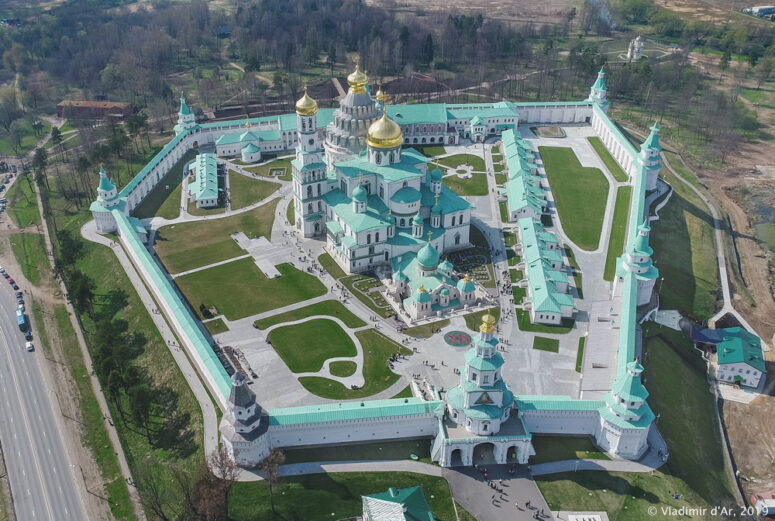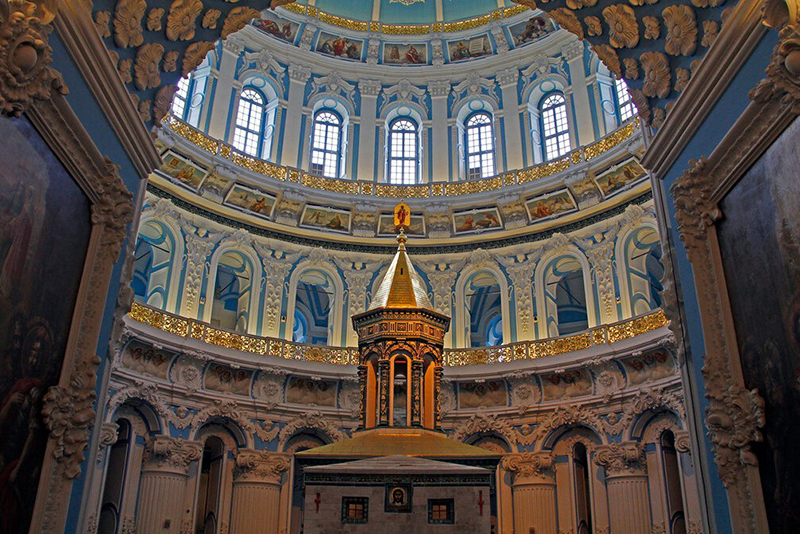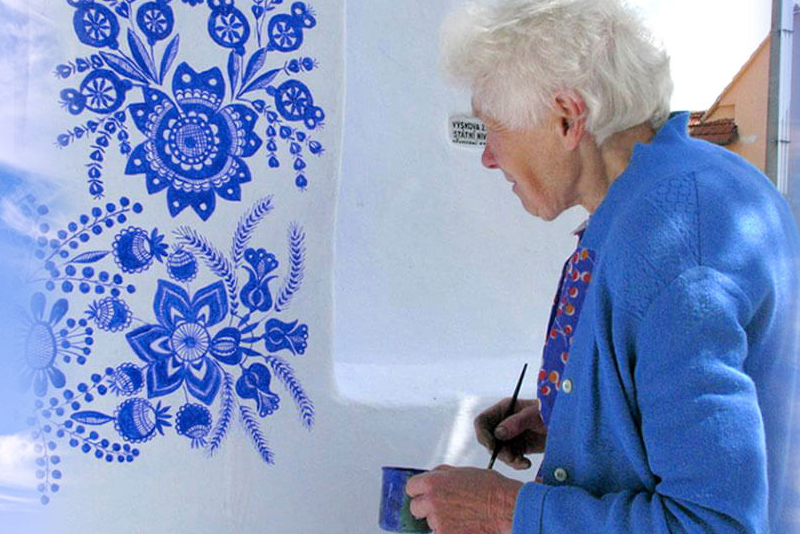
In the 17th century, Patriarch Nikon (+1681) resolved to build outside Moscow the New Jerusalem Monastery of the Resurrection resembling the places of Christian worship in the Holy Land. At the beginning of the construction, he probably had little idea just how long it would take to complete and how durable his project would be. The monastery has been devastated by numerous fires and wars, and it has been rebuilt multiple times after. After its most recent renovation, this unique Russian monastery opened its doors once again to every worshipper who cannot travel to the Holy Land. Like a replica of an icon, it is just as sacred and filled with God’s grace as its counterparts in Palestine.

The Stavroprigial New Jerusalem Monastery of the Holy Resurrection is one of the three monasteries built by His Holiness Patriarch Nikon, the other two being the Iversky Monastery and the Monastery of the Holy Cross. It was also his favourite project. He moved here shortly after its completion in 1656. He stayed at the monastery for more than eight years and spared no effort to create in Russia a replica of the famous Church of the Resurrection of our Lord Jesus Christ and its surrounding landscape. In those years, going on a pilgrimage to the Holy Land was as risky as it was long and expensive. He wished to reconstruct for the Russian people the setting in which Christ suffered His passions and rose from the dead.

To copy the original as closely as possible, His Holiness sent to the Holy Land a learned scholar, Hieromonk Arseny (Sukhanov). The hieromonk returned with the design, plan and model of the Church of the Resurrection of Christ.

Patriarch Nikon’s plan was not limited to copying the Church of the Holy Sepulchre. He wished to place it among the replicas of the other holy sites of Jerusalem. The Church of the Resurrection resembles the Church of the Holy Sepulchre, and the basement Church of Saint Constantine and Saint Helen is similar to the cave church of Palestine. The refectory church was consecrated in honour of the Nativity of Christ. Local geographical features were also given names from the Gospel texts. The monastery stands on the Mount of Zion. To the east is the Mount of Olives, and the stone chapel on it is the Chapel of Olives. A short distance to the North is Tabor Hill, the river flowing nearby was named the River Jordan, and a small grove next to the monastery was called the Garden of Gethsemane. On the banks of the Jordan River stands the hermitage of Patriarch Nikon. Completed in the middle of the 19th century, it received the name “refuge of a recluse”.

The monastery owes its present name – the New Jerusalem – to the Russian Tsar Alexey Mikhailovich. It came to his mind as he was overlooking the monastery from the top of the Mount of Olives soon after the consecration of the Church of the Resurrection in 1657.
He made significant and frequent donations to the construction of the monastery. However, false reports from the jealous boyars soured his relationship with the Patriarch. He discontinued his donations, the construction came to a halt.
In 1666, Patriarch Nikon was deposed and sent into exile as a monk. The exile lasted 15 years. The next Tsar, Feodor Alexeevich, was a disciple of Nikon, and thus sympathetic towards him. He facilitated his return to the patriarchal throne in 1681. The Tsar also resumed donations and asked Nikon to return to the monastery that he had founded. However, the patriarch, who was old and in poor health, did not reach the monastery and died on his way. On orders from the Russian Tsar, he was buried with all honours in the Chapel of the Beheading of John the Baptist of the Resurrection Cathedral. At his grave, multiple healings and omens of God’s grace have occurred, indicating that his departed soul had found refuge in the Heavenly Jerusalem. In 1682, he was officially restored in the dignity of Patriarch of All Russia.

Subsequent Russian monarchs continued to hold the New Jerusalem Monastery in great esteem. Empress Elizaveta Petrovna led the rebuilding of the Church of the Resurrection destroyed almost entirely when the hipped roof of its rotunda collapsed in 1723, and after the fire in 1726. Empress Ekaterina II financed the landscaping works and the reconstruction of the monastery’s buildings after the fires of 1762 and 1792.
In the 19th and early 20th centuries, the monastery was a highly popular place of pilgrimage. It was in great favour with the Russian royal family, as evidenced by its large donations towards its current needs.

However, after the coming to power of the Soviet government in 1919, the monastery was closed. The State Museum of Art and History was established in its place in 1922. In 1941, the invading Nazis destroyed the Church of the Resurrection and most other architectural monuments of the monastery.

The rebuilding of the monastery did not begin until the 1950s. In 1959 the monastery rose from the ruins – its main structures were back in place. Orthodox worship resumed in 1994 and has continued to this day. However, the monastery was not fully rebuilt until 2016.
Interesting facts about the Church of the Resurrection
In its present form, it does not imitate the churches of the Holy Land in exterior or interior appearance. The monastery’s architecture has preserved a multitude of Russian traditional features. Furthermore, even though all of its buildings were designed as miniature copies of their prototypes, the Church was still considered large by Russian standards, especially for its time. For Patriarch Nikon, the goal was to convey the spirit and significance of the Holy Land.


The architectural ceramics that make the cathedral distinct among others were designed under Patriarch Nikon for its inner and outer walls. They have survived to this day, especially on the southern walls of the exterior and in the interior decor.


As we examine the details of the interior, we find more similarities between the Russian Church and its prototype. This should not surprise us, as the plan of the Cathedral of the Resurrection was modelled on the churches of the Holy Land.

Visible similarities can be found in the Cubiculum, the High Place, the Stone of Unction and its twenty-nine side churches. The consecration of the churches followed the historical tradition as far as possible. Still, the names given to them were rather unusual, e.g. Church of the Division of the Garments of Jesus, or Church of the Crown of Thorns. The side church with the latter name was never consecrated, as the Russian church calendar has no feast of the thorny crown. In the original design, the number of the side churches was to equal the number of days in a year, but it was never realised in full because of differences in the church tradition.
Similarly to the church in Jerusalem, the Church of the Resurrection had a space behind the altar, which was unusual for Russia. A stairway that began in this space led to the basement church.

The rotunda in which the Cubiculum is found is untypical of Russian church architecture. Patriarch Nikon was a known opponent of building churches with tabernacle roofs, but he made an exception for this church to achieve closer resemblance with its prototype in Jerusalem. We know that the building of the Rotunda did not finish in the patriarch’s lifetime. They began to build the rotunda from wood, but in the 1680s the plans changed. The structure was build from brick. It stood for forty years until it collapsed in 1723 on the day of the Resurrection of Christ. For financial reasons, the church was not rebuilt until the reign of Empress Elizaveta Petrovna. The new wooden tabernacle was completed in the 1750s and had 60 windows. Paintings on the themes of the Gospel were placed between them. The tabernacle structure was a spectacular achievement of church architecture for its time. However, it did not survive the Nazi invasion. The modern tabernacle church was rebuilt to resemble the original as closely as possible.



Interestingly, the Holy Sepulchre of the New Jerusalem in Russia is closer to the original form than the Holy Sepulchre in Jerusalem, which had undergone a series of major redesigns.

We have reviewed just a few of the features of this amazing church and monastery, fragments of the Holy Land in Russia. There is no better way to appreciate their splendour than to pay a visit. When going to Jerusalem is not a possibility, one can travel to the New Jerusalem outside Moscow instead. Patriarch Nikon built it to give us this option.





Fascinating! I knew nothing about this. Great article!
Thank you for the kind words!